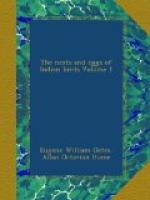“These Orioles are very common here, and I found three nests: one was new and empty; from another the birds had just flown; while the remaining one contained one fresh egg. The bird would no doubt have laid more; but to get at the nest I had to cut the branch off, and it was only then I discovered that only one egg had been laid.”
Major C.T. Bingham says:—“Plentiful at Allahabad across the Ganges, notwithstanding which I only found one nest, and that I have no note about, but I remember it was some time in June, and contained four half-fledged young ones; the materials of the nest were the same as those used by O. kundoo.”
Writing of his experience in Tenasserim he adds:—“On the 5th March I found a nest of this bird in a small tree near the village of Hpamee. It, however, contained three unfledged young, so I left it alone.
“On the 21st April I found a second nest suspended from the tip of a bamboo that overhung the path from Shwaobah village to Hpamee. This contained two awfully hard-set eggs, white, with a few dark purple blotches and spots at the larger ends. Nest made of grass and dry bamboo-leaves, lined with the dry midribs of leaves, and firmly bound on to the fork of the bamboo with a strip of some bark.”
Mr. Oates writes from Pegu:—“My nests of this Oriole have been found in March, April, and May, but I have no doubt they also breed in June. No details appear necessary.”
Typically the eggs are somewhat elongated ovals, only slightly compressed towards one end, but pyriform as well as more pointed varieties may be met with. The shell is very fine and moderately glossy. The ground-colour varies from a creamy or pinky white to a decided but very pale salmon-colour. They are sparingly spotted and streaked with dark brown and pale inky purple. In most eggs the markings are more numerous towards the large end. Some have no markings elsewhere. The dark spots, especially towards the large end, are not unfrequently more or less enveloped in a reddish-pink nimbus. Though much larger and much more glossy, some of the eggs, so far as shape, colour, and markings go, exactly resemble some of the eggs of Dicrurus ater. The eggs of O. kundoo are typically excessively glossy china-white, with few well-defined black spots. The eggs of O. melanocephalus are typically somewhat less glossy, with a pinky ground and more numerous and less defined brownish-purple spots and streaks. I have not yet seen one egg of either species that could be mistaken for one of the other, although of course abnormal varieties of each approach each other more closely than do the typical forms.
The dozen eggs that I possess of this species vary from 1.1 to 1.2 in length, and from 0.78 to 0.87 in breadth, and the average is 1.14 by 0.82. Although the average is somewhat larger than that of the preceding species, and although none of the eggs are quite as small as many of those of O. kundoo, still none are nearly so large as the finest specimens of the latter’s egg. Probably had I an equally large series of the eggs of the present species, we should find that as regards size there was no perceptible difference between the two.




